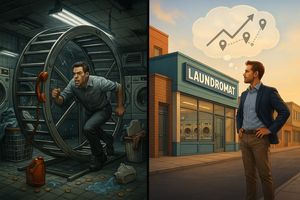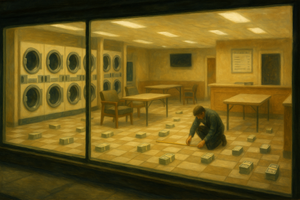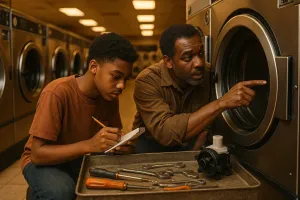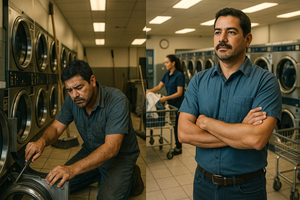Where Laundry Owners Shape Their Businesses for Tomorrow
Limited Seats. Unlimited Opportunity.
Join the exclusive circle of laundry industry owners/operators driving real change. This isn't a conference, it's the strategic advantage successful owners/operators don't skip.
✓ Elite Access - Connect with peers driving breakthrough results
✓ Proven Results - Access proven strategies from top performers
✓ For Owners/Operators - Carefully curated empowering content and speakers
"Finally, a detailed event designed for Laundry Owners by Laundry Owners."
— Multi-Store Owner/Operator
Reserve your seat today.
Limited capacity for this gathering.
Last week, I covered a shift for a team member who had a family emergency. Nothing unusual there, it's part of being an operator/owner who's built systems that let me step in when needed. But what happened that day revealed something I hadn't fully understood about the different ways we experience our businesses.
For those few hours, my mind was consumed by the immediate, answer the phone, work the counter, rack orders, start processing wash-and-fold, sort and tag dry cleaning. Every thought was about the next task, the next client, the next ticket.
Then the relief shift arrived. After briefing them and handing over the store, something fascinating happened. Within minutes, my brain shifted gears. Suddenly I was thinking about our client service software updates, new signage possibilities, the needed paint job, training improvements for the team, and more.
Same store. Same me. Completely different mindset.
Two Worlds Every Owner Navigates
What I experienced that day were two distinct mental states that I now think of as Task Mode and Vision Mode.
- Task Mode is survival thinking. It's putting out fires, handling the immediate, making sure the basics get done. When you're in task mode, your brain doesn’t see beyond the next client complaint or machine breakdown. You're thinking "sweep the floor, wipe the counter, clean the windows." You’re thinking the right now.
- Vision Mode is strategic thinking. It's seeing possibilities, spotting inefficiencies, imagining improvements. This is when you notice the clinet flow patterns, hear whether the music is too loud, feel if the store temperature is comfortable.
This connects directly to something I wrote about in our Inattentional Blindness editorial. When you're focused on tasks, you physically cannot see the strategic opportunities. Your brain filters them out as irrelevant to immediate survival.
What Research Tells Us About Presence
A Harvard Business School study on Management by Walking Around found something counterintuitive, physical presence of managers actually had a negative impact on performance, unless it enabled active problem solving.¹ The key finding? Being there isn't enough. What matters is how you're present.
This mirrors what researchers found when studying founder led companies. A Purdue study discovered that S&P 500 companies where founders remain involved generate 31% more patents and outperform their peers.² But here's the crucial part, these founders aren't successful because they're working the counter. They succeed because they maintain what Bain & Company calls "front-line obsession”, a deep curiosity about what's actually happening in their business.³
The research points to three characteristics of successful founder led companies:
- An insurgent mission (clear purpose)
- Front line obsession (love of details and client experience)
- Owner's mindset (personal responsibility and speed to act)
Notice what's missing? Nowhere does it say "founders who handle daily operations." Instead, it's about maintaining strategic engagement while building systems that handle the tactical.
The Seductive Trap
Some in and outside our industry love to sell the dream of the passive laundromat. Build it right, they say, and you can manage it from a beach in Tahiti or with only a couple hours a week. This narrative is so seductive because it promises freedom from the grind of daily operations.
And you know what? Building systems that free you from having to be there is important. The Small Business Administration reports that 50% of small businesses fail in the first year and 95% fail within the first five years, with poor management cited as the primary cause.⁴ You can't manage strategically if you're trapped behind the counter.
But here's what the passive income prophets miss, there's a massive difference between building systems so you don't have to be there and actually choosing not to be there.
I've seen and listened plenty of laundromats operate on the "if it ain't broke don't fix it" model. The owner checks monthly P&Ls, collects distributions, visits once in a while. Are they technically successful? Sure, if you define success as "still operating." But are they thriving? Growing? Adapting to change?
What Vision Mode Reveals
When I walk through our stores now by choice rather than obligation, I notice things my task focused self never could:
- How the client flow creates bottlenecks
- The subtle grinding sound from a machine
- The way our radio makes phone conversations difficult
- How the afternoon sun creates glare on our payment kiosks
- Which team members naturally help confused clients
- Where clients hesitate and pause
My team members, locked in perpetual task mode, don't notice these things. It's not because they don't care, it's because their brains are occupied with immediate operational needs. They're in survival mode, just like I was during that coverage shift.
This is exactly what the research on management by walking around discovered. Physical presence only adds value when it enables you to spot and solve problems others can't see.¹ When you're there by choice, you see with strategic eyes. When you're there by necessity, you see the next task.
The Evolution of Engagement
Looking back at my journey, I can see clear phases:
Early days: Had to be there, thought only about tasks
Growth phase: Started building systems to free myself from daily operations
Current state: Choose to be present, naturally connect tasks to strategic vision
Now when I observe something tactical, I automatically think strategically. A team member has to do X at the store, but how does X affect the client experience? How can we build this into our systems better? What would make this standard practice across locations?
This evolution didn't happen overnight. It required building systems, team members, and importantly, creating the mental space to think beyond survival.
Finding Your Balance
I'm not here to tell you that my way is the only way. Some owners genuinely thrive with minimal physical presence, managing through metrics and systems alone. Others need daily involvement to feel connected and energized.
The key is understanding the trade-offs:
Minimal Presence might work if:
- You have exceptional systems and team members
- Your market is stable with little competition
- You're satisfied with steady-state operations
- You have other ways to stay connected to customer needs
Strategic Presence might serve you better if:
- Your market is competitive and rapidly changing
- You're still discovering improvement opportunities
- You energize from customer and team interaction
- You want to drive continuous innovation
What matters isn't choosing one extreme or the other. It's recognizing that building systems to free yourself from task mode is just the first step. The real question is, what will you do with that freedom?
Thinking about the thinking of laundry:
When you realize there's a difference between being trapped in your business and choosing to engage with it.
The goal isn't to build a business you can abandon. It's to build a business you don't have to be in, then choose to engage with it in ways that create the most value. Sometimes that's from a distance through metrics and systems. Sometimes it's walking the floor with strategic eyes.
In my experience, the magic happens when you have the freedom to choose.
That's all I got for you today.
Waleed
Join me on Linkedin, YouTube, or X (Twitter)
Echoing the thoughts of Michael Gerber.
The entrepreneurial myth is that businesses are started by entrepreneurs, when in fact most are started by technicians suffering from an entrepreneurial seizure.
Footnotes:
¹ Tucker, A. L., & Singer, S. J. (2015). The Effectiveness of Management-By-Walking-Around: A Randomized Field Study. Production and Operations Management, 24(2), 253-271.
² Zook, C. (2016, March 24). Founder-Led Companies Outperform the Rest — Here's Why. Harvard Business Review.
³ Zook, C. & Allen, J. (2016). The Founder's Mentality. Bain & Company Insights.
⁴ What Causes Small Businesses to Fail? U.S. Small Business Administration statistics.





